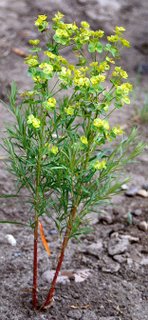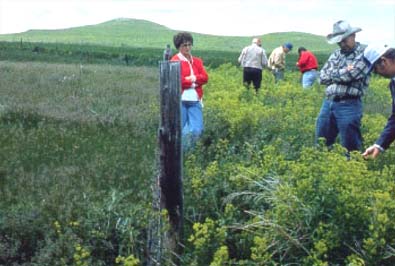 This is the post no one will read.
This is the post no one will read. At some level, I don't blame them -- it's hard to learn about plants without seeing them, and so many plants look alike. On the other hand, it's a little disconcerting that the average person going into forest and farm cannot name a single common plant or tree. This is not to say I am any good at it either -- but I at least try.
One reason to learn a little about plants is that they can tell you a lot about the water level, the drainage, how recently the soil was disturbed, and what might be grazing in an area. Plants also convey a little environmental history as well.
If you are looking over a field and see a large
poke berry thicket rising up in the middle of it, for example, there's a good chance a groundhog den will be located there -- the poke berry will have taken advantage of the disturbed soil at the edge of the den hole to germinate its seed. By looking at the age of poke berry plants in a hedge, you may be able to get some idea of when the area was last plowed or cut over -- the larger the poke berry, the more likely the dens are going to be a bit older and more well-established.
Conversely, if you see the beautiful purple flowers of
iron weed growing across a low swale in a field, you can give that area a pass -- it will be too wet for a den.
A lot of the plants we see in our hedges and border areas are non-natives. These included
multiflora rose,
ghetto palm,
Chinese tear-thumb, mimosa, Japanese honeysuckle, kudzu, oriental bittersweet and garlic mustard.
An invasive we found a lot of this last weekend was Leafy Spurge (
Euphorbia esula). There are a bunch of spurge types, and they all look different. Leafy Spurge is aggressive even among spurges, and it can quickly suffocate field edges if they have been disturbed by a plow and then left to fend for themselves. This is a plant that was once described to me as "horse tail," but in fact it is not related to that ancient plant; it may simply be a local name for the weed.
Right now, before Leafy Spurge flowers, the 3-foot plants look a lot like tropical aquarium plants, with rosettes of thin upright leaves around central stalks. In a few weeks, the odd yellowish flowers will begin to come on, making the plant appear greenish-yellow -- a bit like a field of turning-to-flower rape seed.
Leafy Spurge is really quite pretty. The down side is that it is quite useless as a forage for cattle, deer, and horses, and it is so aggressive that it tends to drive out everything else that can be eaten by wildlife.
If you break Leafy Spurge in half, a white milkish sap will ooze out. This sap is most common in adult plants, and its presence is what puts off deer, cow and horses. Deer may graze on very young Leafy Spurge shoots in early Spring when there is very little milk sap, but they will give it a pass by mid-Summer when it begins to flow. Turkey and other birds seem to have little or no interest in the seeds.
Leafy Spurge showed up in the U.S. in the early 1800s, first migrating to the U.S. from Eurasia, perhaps as a stow-away in a bag of farm seed. Tumble weed (aka Russian Thistle) arrived on our shores much the same way.
Leafy Spurge was first recorded in Massachusetts in 1827 and it quickly spread west and is now found across the U.S. except for the southeastern U.S. below Virginia.
In Virginia and Maryland, Leafy Spurge seems to be doing quite well -- I assume the slightly hotter and moister climate farther South is too much for it -- at least for now. There appear to be several varieties of Leafy Spurge, and new American hybrids seem to be occurring naturally. Before it's all over, Leafy Spurge may yet find a way to colonize the South.
Leafy Spurge is spread by seeds which readily germinate in disturbed soil. Once this plant takes root, it is very difficult to winkle out by plow and poison.
The root structure of Leafy Spurge is key to its survival -- not only does it have long surface-running roots capable of sucking up lots of water (and creating new colonies of Leafy Spurge), but is also has deep tap roots which can shoot six or seven feet underground in order to tap water unavailable to other plants. No matter how hot and dry the summer is, a field of Leafy Spurge is likely is look prosperous.
Biological control offers some small hope of controlling Leafy Spurge. The U.S. Department of Agriculture has imported six natural enemies from Europe, including a stem and root-boring beetle, four root-mining flea beetles, and a shoot-tip gall midge (whatever that is). Large scale field-rearing and release programs for these insects are being carried out by federal and State agencies in many northern states. While the results are not immediate, they are impressive over time ... so long as pesticides are not used.
Another option that works well to reclaim pastures overgrown with Leafy Spurge, is a herd of goats or sheep. While cows and horses generally prefer grass, and will give Spurge and other forbs a pass, the goats and sheep will readily attack the Leafy Spurge and seem to prefer it over grass. Over time, sheep and goats can transform a field from a "waste case," to grazeable pasture, as the picture below suggests.
 A spurge-infested field in Montana is cleaned up by goats and sheep at left -- a job not accomplished by cattle and horses at right.
.
A spurge-infested field in Montana is cleaned up by goats and sheep at left -- a job not accomplished by cattle and horses at right.
.


















































